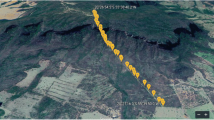Summary
The foraging activities of termites were measured at nine sites distributed along a rainfall gradient in Tsavo National Park, Kenya. Dead wood disappearance (D, g m-2a-1) was mainly attributable to termites and was related to rainfall (R, mm a-1) by the equation
Foraging activity was highest during rainy seasons and declined to low levels during the long dry season. The number of species increased with increasing rainfall while the importance of fungus growing Macrotermitinae declined.
Similar content being viewed by others
References
Bouillon A (1970) Termites of the Ethiopian region. In: Krishna K and Weesner FM (eds). Biology of termites, vol 2. Academic Press, New York and London, pp 153–280
Buxton RD (1979) The Role of Termites in the Ecology of Tsavo National Park, Kenya. D. Phil. Thesis, Oxford
Buxton RD (1981a) Termites and the turnover of dead wood in an arid tropical environment. Oecologia (Berl) 51:379–384
Cobb SM (1976) The distribution and abundance of the large herbivore community of Tsavo National Park, Kenya. D. Phil. Thesis, Oxford
Coe MJ, Cumming DH, Phillipson J (1976) Biomass and production of large african herbivores in relation to rainfall and primary production. Oecologia (Berl) 22:341–354
Collins NM (1977a) Vegetation and litter production in southern Guinea Savanna, Nigeria. Oecologia (Berl) 28:163–175
Collins NM (1977b) The population biology and energetics of Macrotermes bellicosus (Smeathman) Isoptera. Ph. D. Thesis, University of London
Collins NM (1977c) Oxford expedition to the Edea — Marienberg Forest Reserve, United Republic of Cameroon, 1973. Bulletin of the Oxford University Exploration Club, New Series 3:5–15
Davidson DW (1978) Worker size variation in a social insect as a function of the competitive environment. Amer Nat 112:523–532
Haverty MI, Nutting WL (1975) A simulation of wood consumption by the subterranean termite, Heterotermes aureus (Snyder), in an Arizona desert grassland. Ins Soc 22:93–102
Josens G (1972) Etudes biologiques et écologiques des termites (Isoptera) de la savane de Lamto-Pakobo (Côte d'Ivoire). Thèse ès Sciences, Bruxelles
Kingston TJ (1977) Natural manuring by elephants in the Tsavo National Park, Kenya. D Phil Thesis, Oxford
Lee KE, Wood TG (1971) Termites and Soils. Academic Press, New York and London
Lepage M (1974) Les termites d'une savane Sahélienne (Ferlo Septentrional, Sénégal): peuplement, populations, consommation, rôle dans l'écosystème. Thèse ès Science, Dijon
Nielsen MG, Josens G (1978) Production by ants and termites. In: Brian MV (ed) Production ecology of ants and termites. Cambridge University Press, pp 45–53
Rosenzweig ML (1968) Net primary production of terrestrial communities: prediction from climatological data. Amer Nat 102:67–74
Sands WA (1965) Mound population movements and fluctuations in Trinervitermes ebenerianus Sjostedt (Isoptera, Nasutitermitinae). Ins Soc 12:49–58
Southwood TRE (1978) The components of diversity. In: Mound LA and Waloff N (eds) Diversity of insect faunas. Blackwell Scientific Publications, Oxford, pp 19–40
Usher MB (1975) Studies on a ground feeding termite community in Ghana, West Africa. Biotropica 7:217–233
Wijngaarden W van (1979) Soils and vegetation of the Tsavo are. Reconnaissance Soil Survey Report no 7, Kenya Soil Survey, Nairobi
Williams RMC (1973) Evaluation of field and laboratory methods for testing termite resistance of timber and building materials in Ghana, with relevant biological studies. Centre for Overseas Pest Research, Tropical Pest Bulletin no 3, London, HMSO
Wood TG (1976) The role of termites (Isoptera) in decomposition processes. In: Anderson JM and Macfadyen A (eds) The role of terrestrial and aquatic organisms in decomposition processes. Blackwell Scientific Publications, Oxford, pp 145–168
Wood TG (1978) Food and feeding habits of termites. In: MV Brian (ed) Production ecology of ants and termites. Cambridge University Press, pp 55–80
Wood TG, Johnson RA (1978) Abundance and vertical distribution in soil of Microtermes (Isoptera, Termitidae) in savanna woodland and agricultural ecosystems at Mokwa, Nigeria. Memorabilia Zool 29:203–213
Wood TG, Johnson RA, Ohiagu GE (1977) Populations of termites in natural and agricultural ecosystems in southern Guinea Savanna near Mokwa, Nigeria. In: Malaine F (ed) Structure, function and management of dry and wet tropical forests and savanna ecosystems. Proc 3rd Int Confer trop Ecol, Lumumbashi, Zaire
Wood TG, Sands WA (1978) The role of termites in ecosystems. In: MV Brian (ed) Production ecology of ants and termites. Cambridge University Press, pp 245–292
Author information
Authors and Affiliations
Rights and permissions
About this article
Cite this article
Buxton, R.D. Changes in the composition and activities of termite communities in relation to changing rainfall. Oecologia 51, 371–378 (1981). https://doi.org/10.1007/BF00540908
Received:
Issue Date:
DOI: https://doi.org/10.1007/BF00540908




